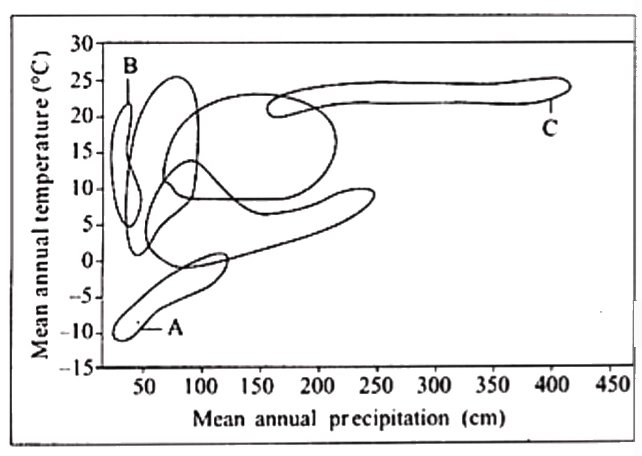−1∘C to 13∘ C annual variations in the intensity and duration of temperature and 50 to 250 cm annual variation in precipitation, account for the formation of a major biome known as
Temperature forest
Coniferous forest
Tropical forest
Grassland
The correct Answer is:B
Step by step video, text & image solution for -1^(@)C to 13^(@) C annual variations in the intensity and duration of temperature and 50 to 250 cm annual variation in precipitation, account for the formation of a major biome known as by Biology experts to help you in doubts & scoring excellent marks in Class 12 exams.
Updated on:21/07/2023Topper's Solved these Questions
- ORGANISMS AND POPULATIONS Book:MODERN PUBLICATIONChapter:ORGANISMS AND POPULATIONS Exercise:COMPETITION FILE (OBJECTIVE TYPE QUESTIONS)(B. MATCHING TYPE QUESTIONS: )
Explore 4 Videos
- ORGANISMS AND POPULATIONS Book:MODERN PUBLICATIONChapter:ORGANISMS AND POPULATIONS Exercise:COMPETITION FILE (OBJECTIVE TYPE QUESTIONS)(C. ASSERTION - REASON TYPE QUESTIONS: )
Explore 10 Videos
- ORGANISMS AND POPULATIONS Book:MODERN PUBLICATIONChapter:ORGANISMS AND POPULATIONS Exercise:REVISION EXERCISES (VI. LONG ANSWER TYPE QUESTIONS)(B. QUESTIONS FROM CBSE EXAMINATIONS)
Explore 8 Videos
- MOLECULAR BASIS OF INHERITANCE Book:MODERN PUBLICATIONChapter:MOLECULAR BASIS OF INHERITANCE Exercise:CHAPTER PRACTICE TEST (Section - E)
Explore 1 Video
- PRINCIPLES OF INHERITANCE AND VARIATIONBook:MODERN PUBLICATIONChapter:PRINCIPLES OF INHERITANCE AND VARIATIONExercise:CHAPTER PRACTICE TEST section-e(Long answer type question)
Explore 1 Video
Similar Questions
Two different rods A and B are kept as shown in the figure. The variation of temperature of different cross-sections is plotted Find the ratio" of thermal conductivities of B to A.
'(##CEN_KSR_PHY_JEE_C13_E01_031_Q08##)'
View SolutionThe graph given below is showing biome distribution with respect to annual temperature and precipitation. Identify A, B and C, respectively.

View Solution
Knowledge Check
−1∘C to 13∘C annual variations in the intensity and duration of temperature and 50 to 250cm. Annual variation in precipitation, account for the formation of a major biome as
Or
Extensive geographical belt of forest known as 'Taiga' belongs toATemperature forestBConiferous forestCTropical forestDGrassland1o C to 13o C temperature and 50 to 250 cm rainfall account for the formation of a major biome
ATemperature forestBConiferous forestCGrasslandDTropical forestDistinct seasons and annual variation in precipitation leads to formation of major biomes.
Reason:- Distinct seasons and annual variation in precipitation leads to development of different climatic conditions which favours growth and development differentially.AIf both Assertion & Reason are True & the Reason is a correct explanation of the Assertion.BIf both Assertion & Reason are True but Reason is not a correct explanation of the AssertionCIf Assertion is True but the Reason if False.DIf both Assertion & Reason are false.
Heat is flowing through a rod of length 25.0cm having cross-sectional area 8.80cm2. The coefficient of thermal conductivity for the material of the rod is K=9.2×10−2kcals−1m−1.∘C−1. The Temperatures of the ends of the rod are 125∘C and 0∘C in the steady state. Calculate (i) temeprature gradient in the rod (ii) temperature of a point at a distance of 10.0cm from the hot end and (iii) rate of flow of heat.
View SolutionA sphere with diameter of 80cm is held at a temperature of 250∘C and is radiating en-ergy If the intensity of the radiation detected at a distance of 2.0m from the sphere 's cnetre is 102W/m2 What is the emissivity of the shere ? .
View SolutionA calorimeter of water equivalent 10 g contains a liquid of mass 50 g at 40.∘C. When m gram of ice at −10∘C is put into the calorimeter and the mixture is allowed to attain equilibrium, the final temperature was found to be 20∘C. It is known that specific heat capacity of the liquid changes with temperature as S=(1+θ500)calg−1.∘C−1 where θ is temperature in .∘C. The specific heat capacity of ice, water and the calorimeter remains constant and values are Sice=0.5calg−1.∘C−1,Swater=1.0calg−1.∘C−1 and latent heat of fusion of ice is Lf=80calg−1. Assume no heat loss to the surrounding and calculate the value of m.
View SolutionIn areas having mean annual temperature of 23∘C to 27∘C and annual rainfall between 75 cm to 100 cm we find :
View SolutionMark the correct statements about major abiotic factors .
I . Temperature on land veries seasonally, increase progressively from the equator towards the from plains to the mountain tops .
II. Light is important in animals as they use the diurnal seasonal variations in light intensity and duration as cues for timing their forging, reproductive and migratory activities.
III. Various characteristics of the soil such as soil composition, grain size and aggregation determine the percolation and water holding capacity of the soils .
IV. The salt concentration is more than 5% in inland waters
View Solution

